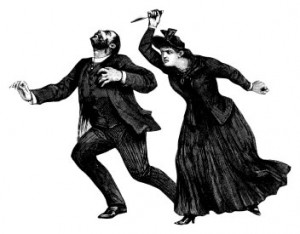Writing for Publication: How to Write a Murder Mystery Story

When writing a murder mystery story for publication, there are four basic places to start:
- You can begin with the victim.
- You can begin with the perpetrator.
- You can begin with the crime itself.
- You can begin with the setting of the crime.
Most of the published mysteries I've read begin with the setting. Background is important: so is atmosphere. In order to write something publishable, the reader must CARE about the characters and what happens to them: in order to get to this level, one MUST supply some background for your imaginary people.
All the published mystery writers do this well. Agatha Christie does this so well, in her murder mystery stories. We know the place and the people intimately; we've been here before, and have seen these stock characters, like the village maiden aunt, the village doctor, the village lawyer, the village vicar or priest, going through their paces in every story. "Market Basing" becomes a second home. "Miss Marple", or "Hercule Pirot" are like old friends which we greet with enthusiasm once again.
A mistake murder mystery writers often make is to start out without sufficient background to make us care about either the victim, the crime or the perpetrator; from page one, we are suddenly plunged into a bloodbath in a hotel room, or see the victim expiring in a refuse-strewn alleyway, without any rhyme or reason.
An opposite mistake mystery writers often make is to give us way too much detail initially; to go on and on about the mists on the river, the sky at dawn, the dark tower glowering over the bluff...endless details of setting, page after page, and virtually unpeopled by anyone recognizable to your ordinary Joe.
Another thing to remember...your average murder mystery fiction afficiondo is a linear thinker. We like to begin at the beginning (which is introducing the people and the place, i.e., supplying the background for the story), go on to the end, and then stop. That's a satisfying story, to our linear minds.

So, you've made the beginning, which is about ten pages, or one chapter, and introduced the main people, and have put them down gently into their appropriate setting(s).
Now, for the development of your story.
You, the murder mystery writer, want to develop this story in one of several ways. It helps to have an outline, which is basically a timeline for the events in the story. Who is where, when. It helps to keep the alibis straight, for one thing. What happens? A list of the events in the story in chronological order also helps. ( You can play with the continuity later on, if you wish, but always keeping in mind that chances are, your readership is composed of LINEAR THINKERS!)
You also want to give some thought to motives, at this point. The whole trick of writing a successful mystery story is to keep the reader guessing, until the very end. One of the several ways to do this is to make sure MANY people have motives; some motives are more apparent than others.
The basic motives that drive a crime are:
- Greed
- Jealousy/Love
- Righteous anger
- Insanity
- Self-defense
Motives are the fun part of writing a murder mystery. Human beings are multi-dimensional. We all have the potential to be bad, very bad! We repress this both for our own sakes and for the sake of all the other people in society. One of the reasons mystery stories are so compelling and so universally saleable is that the mystery fiction gives us a chance to be vicariously BAD, really bad.
If you hate your boss, it's lovely to come across a murder mystery story where the obnoxious boss gets a strong biff on his/her head, causing instant death, and , of course, the mystery of who killed him/her? Should it be a well-populated office, the list of ill-wishers is long indeed.
If you've ever been consumed with sexual jealousy, it's absolutely delightful when the sluttish vamp gets mysteriously poisoned chocolates through the post...Or when the ladies' man, who has broken many hearts and marriages, finally gets his comeuppance with a leaded pipe.
One of the very strong keys to writing a successful murder mystery is to make all the peripheral people, who might possibly be the perpetrator, interesting, multi-faceted, and with believable motives as well, without getting off the track of the main story too far.

The ending of the story should always be a surprise. The legerdemain of misdirection is the mystery writer's meat and drink.
We, the readers, should not be able to guess whodunit, even though the mystery writer has played fair with us and scattered enough clues about.
What the competent mystery writer does is give us clues, but minimizes the importance of the most telling clues, and obscures those clues amongst a cloud of false leads, or red herrings. It's easy for the mystery writer to to this. He/she is God and can do anything, make anything happen or not happen, on the page.
The mystery writer needs to know precisely where the story is going, before he/she has begun to write, but needs to protect that information all throughout the development of the story. The reader should NOT be able to guess the ending.
Generally speaking, the real protagonist of the mystery story is the detective who solves the crime.
Now, for one thing, we want a repeatable protagonist, where this same detective is met again and again in succeeding stories. So the most sympathetic character one creates is the detective, and the detective is given more detail, outlined more thoroughly, and often given a sidekick of some sort. Most often, the story is written from the detective's point of view, which automatically lets us into the detective's mind.
This person may be an amateur, (which, as a reader, I personally find the most sympathetic and easiest to digest) or, the detective can be a policeman, whose job it is to solve crimes.
If you make your detective a policeman, it is very wise to be prepared by knowing basic police procedures and basic criminal law. A couple of books on those subjects is almost mandatory for the creator of a police detective in fiction.
The good thing about making your detective a policeman is that the policeman naturally has many, many opportunities to be connected with crimes of all kinds. This helps the repeatability of the protagonist.
An amateur, on the other hand...well, let's say it starts stretching one's credibility when Miss Marple is off investigating her sixth or seventh murder...In ordinary life, a person is rarely confronted with murder even once. (Fortunately for us all!)
There you have it, the basics for writing a murder mystery story for publication.
Good luck, and here's to crime!








